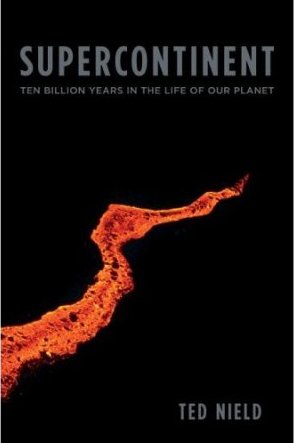
Supercontinent
Ted Nield
288 pages, including index
Published in 2007
I've read other good books on geology and the history of the Earth, notably Richard Fortey's books, but this is the best one volume introduction to the idea of continental drift and the underlying dynamics driving it that I've seen. Nield is very good at explaining difficult concepts to a lay reader without simplifying them into incoherence. I took a gamble on Supercontinent when I saw it in the Amsterdam library just because Nield chose to introduce his subject with a short science fiction story about what would be left of us if aliens visited Earth 200 million years from now, when our current continents have all recombined again to form one Supercontinent. A catchy way to get my attention and fully justified by the rest of the book.
Supercontinent is both about the geological history of Earth as expressed through the ways continents have drifted apart, collided and fused together and broken up again and the history of the intellectual discovery of this history. As you might expect from the relative shortness of this book, barely 270 pages not counting index and notes, Nield provides only a broad overview, but he has an eye for the telling detail and manages to pack a lot of explanation into few words. For example, below is how he explains the recurring opening and closing of the "Atlantic Ocean" in the process called introversion and how this leaves parts of mountain chains on different sides of the ocean:
In other words, oceans can open and close, like a carpenter's vice, more than once. Imagine that you open a vice, put the carpenter's lunch (cold lasagne) into it and squeeze it tight. The lunch will ooze out and up, forming a mountain chain, which we shall call the Lasagnides. You then leave it until the lasagne has gone hard before opening the vice again. By now agents of erosion -- mice -- have scoured the once mighty Lasagnides back to bench level; but their roots, within the vice itself, remain. If you now reopen the vice to start the process again, some of hose olde Lasagnide remnants will stick to one jaw and some to the other/ but the vice reopens along the same basic line. That is how you get some parts of the same mountain chain in Europe and others in America.
Witty, clever and instantly understandable. And he does this again and again in this book. Not just with explanations, but with the images he creates: talking about the Drake Passage between South America and Antarctica as "a section through a piece of armour plating pierced by a high-velocity round", or of atmospheric convection cells as "sitting around each hemisphere like the folds of rubber flesh surrounding M. Michelin". More than just clever similes, these images translate complex ideas into a form any reasonably intelligent reader can understand. Some information may of course be lost in this translation, but that's part and parcel of writing a pop science book.
Supercontinent's main theme revolves around Pangaea and the idea that all the continents once fitted together. Though this idea was only accepted fairly recently in the sixties, it was actually first realised as long ago as 1596 by the Flemish mapmaker Abraham Ortelius, who first noticed how well South America and Africa fit together. More clues to continental drift were found in both the distribution of living animals and plants as well as fossils long before a mechanism for it was proposed. Which meant that despite increasing evidence for it, the idea of continental drift and the existence of Pangaea was long derided as pseudoscience. Nield is not ashamed of this and in fact cites from various non-scientific traditions (e.g. Tamil mythology) to show how widespread this idea was even before it was scientifically proven. This history of how Pangaea went from wild idea to proven hypothesis is one strand of this book.
The other is to show how this cyle of formation and breakup of supercontinents works and how this has an impact on everything else: climate, weather, even life. According to Nield, there's a good chance that the existence of multicellular life (including ourselves) is due largely to the existence of a pre-Pangaea supercontinent called Rodina ("motherland" in Russia). It was the existence of this supercontinent that allowed Earth to be cooled down enough to become completely iced over (Snowball Earth) and somehow this condition led to the emergence of complex, multicellular life when for hundreds of millions of years all life had been singlecelled up to then.
Both stories are told with lots of digressions and interesting tidbits, somewhat fragmented occasionally, but it all fits together in the end. Along the way a great many geological ideas pass the revue, like the reason mountains are actually lighter than their surrounding continents which in turn is lighter than the oceanic bedrock they "float" on. Nielsen is also keen on showing how this seemingly esoteric knowledge impacts on our own lives, in more than just the abstract way descibed above. With the 2004 Idian Ocean tsunami fresh in our memories, Nield grows passionate as he explains how dangerous the denial of deep time is:
You cannot pick and chose with science. A seemingly rarefied geology that reconstructs the lost supercontinents of Earth's deep past is the same science that (with political will) can save hundreds of thousands of lives in the Indian Ocean when the next tsunami strikes. The arcane business of how our Earth's atmosphere evolved during the Precambrian under the influence of evolving life is the same science that helped us understand the massive, uncontrolled climate experiment in which the human race is currently engaged. But to deny one part of science is to deny it all. Science hangs together. It is a supercontinent.
Which is perhaps the most important message in this book.